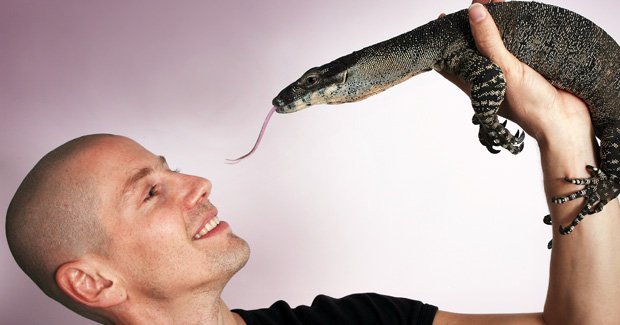Lizard venom may treat heart disease

FROM THE DEEPEST REACHES of the Australian desert to the cloud forests of Mexico, the University of Melbourne’s Dr Bryan Fry has been on the trail of a group of lizards – and, more specifically, their venom.
One of the key results of his team’s study of so-called ‘anguimorphs’ – which include monitor lizards and the komodo dragon – is the discovery of three toxins that lower blood pressure. The team hopes this could one day lead to new drugs to treat people.
It was only four years ago that the same international team reported finding that venom is widespread in lizards, not restricted to a few species, as had been thought. In a bid to find out more, the researchers extracted and analysed venom from 23 different lizards.
“Religious experience”
Bryan himself spent a lot of time in the field. “Going deep into the Sindh Desert of Pakistan was by far the most hard-core travelling I have done,” he says. “And looking into the deeply intelligent eyes of a wild komodo dragon is as close to a religious experience as I am ever going to get.”
The team found that while all the species they studied shared a few of the same toxins, “the venom is as diverse as the lizards,” says Bryan. There are also variations in how the lizards use their venom.
For the beaded lizard and gila monsters, their venom is their most important weapon, and the main function of their teeth is to deliver the toxins to their prey. The komodo dragon, however, has very sharp teeth that can inflict deep, shark-bite-like wounds. “The venom plays a supporting role to keep the blood from clotting and to induce shock and low blood pressure,” says Bryan.
Oozing venom
With a few exceptions, including the komodo dragon, the beaded lizard and the gila monster, these lizards aren’t dangerous to people. “They are too small, with too little venom that oozes in sustained chewing, rather than being delivered through hypodermic fangs, like with a cobra,” he explains.
But while a komodo dragon, for example, can hurt a person, more work on its venom might lead to new drugs to treat people with high blood pressure, the team hopes.
That’s a reasonable hope, says Professor Rick Shine, an expert on lizards at the University of Sydney.
“Conservationists generally assume that it’s self-evidently true that lizards are worthwhile – after all, these creatures are elegant, beautiful and play important roles in ecosystem function,” he says. “But for the non-lizard-lovers in our community, these research results point to another good reason why we need to conserve reptiles – they may well enable us to develop many new drugs that can aid human welfare.”
The new study is published in the latest edition of the Journal of Molecular and Cellular Proteomics.
RELATED STORIES
Mass extinction of lizards by 2080
Scale tales: guide to Aussie skinks
Native lizard gives cancer clues
Dragon tales

